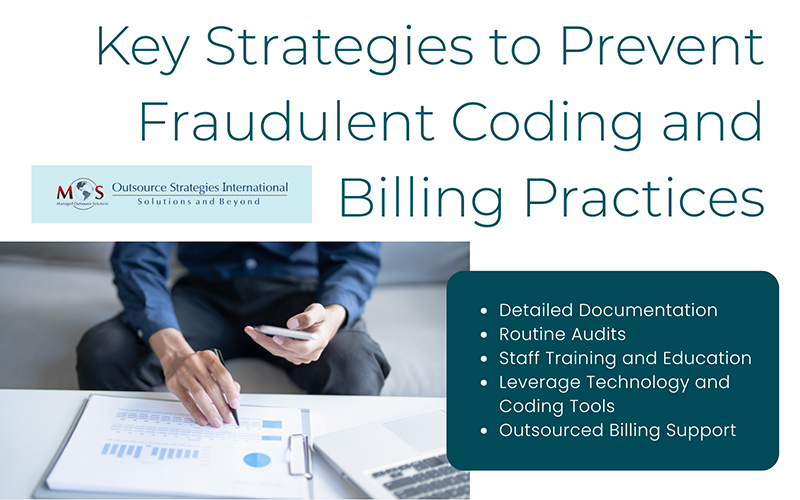Claim submission and denial management are the two steps that typically comprise the major portion of the medical billing workflow. While these steps are the key to obtaining proper reimbursements for healthcare providers, claims would not receive approval from payers unless services rendered are reported using accurate codes. Medical codes are foundational to the entire billing process — errors in coding lead to claim denials, rejections, delayed payments, or even audits. Understanding improper coding practices such as upcoding and downcoding in medical billing is crucial as they directly affect the quality and success of claim submissions.
According to the Office of Inspector General (OIG), fraudulent activities such as upcoding cost the U.S. healthcare system nearly $100 billion annually. This can severely impact not only the integrity of the provider’s billing process but also result in legal repercussions, fines, and lost revenue. With such significant costs tied to improper coding practices, healthcare providers must implement strategic initiatives to ensure accurate coding processes for medical billing compliance. Alternatively, practices can also rely on professional medical coding services to optimize coding without straining in-house resources.
What is Upcoding?
Upcoding, also known as overcoding, refers to the practice of sending an invoice to the insurance provider with higher-level codes for a service than what was actually rendered. Whether it’s done intentionally or accidentally, this practice is deemed as healthcare fraud by payers and government programs. While it may temporarily lead to higher reimbursements from insurers, this results in long term consequences such as increased scrutiny from regulators, penalties, and medical license revocations.
Upcoding may result from simple human error or, in some cases, be used unethically to cope with financial pressures and boost reimbursement. For instance, a doctor performs a basic office visit but codes it as a more complex consultation that requires more time and resources to get paid more. Such fraudulent billing practices not only lead to claim denials and legal and financial risks, but also damage reputation, reduce patient satisfaction, and weaken trust.
These errors can occur due to inaccuracies in medical documentation or misinterpretation of services provided by the coders. Healthcare providers can minimize the chances of upcoding with optimized billing process, regular staff training, compliance programs, and internal billing audits.
What is Downcoding?
Downcoding, also known as undercoding, is another practice that affects coding compliance in healthcare. It involves assigning lower-level codes to a service or procedure, even if they warrant higher compensation. While upcoding overstates procedures for higher payment, downcoding does the exact opposite by under-representing the level of care provided. This practice is often the result of inaccurate documentation. However, some providers may intentionally undercode to reduce risk of denials or avoid audits associated with overcoding. It can occur if the coding team isn’t familiar with the latest codes or billing guidelines, or when insurers downcode claims that are submitted with documentation that does not meet their criteria.
Regardless of the reason, undercoding is also a fraudulent billing practice that results in lower reimbursement rates, leading to lost revenue and potential compliance issues. This, in turn, contributes to strained resources, administrative overload, burned out staff, and long-term financial hardships for practices. Since undercoding may translate to higher out-of-pocket costs for patients, it can significantly impact the provider-patient relationship.
If the downcoding is triggered from the insurance company’s side, it may stem from discrepancies in the submitted documentation, lack of medical necessity, or failure to meet specific coding criteria. In such cases, insurers may automatically assign a lower code, leading to reduced reimbursement. This can significantly affect a provider’s revenue cycle, especially if it happens repeatedly or goes unnoticed. To address this, healthcare providers must dispute the payer’s decision by filing an appeal and submitting sufficient documentation to justify the higher codes. This can be a time-consuming process as practices must collect supporting records, and engage in back and forth communication with the payer.
Key Difference between Undercoding and Overcoding
| Upcoding | Downcoding |
|---|---|
| Billing higher-level codes than the services provided | Assigning lower-level codes than warranted |
| Considered fraudulent billing by payers | Under representing level of care for lower reimbursement |
| Can be accidental or intentional due to financial pressure | Often due to inaccurate documentation or intentional to avoid audits or denials |
| Causes regulatory scrutiny, penalties, and license revocation | Leads to lost revenue, staff burnout, and tight resources |
How to Prevent Upcoding and Downcoding in Medical Coding

Healthcare providers can prevent fraudulent billing practices and mitigate the risks associated with them by implementing the following strategies:
- Detailed Documentation
An accurate and comprehensive medical record is essential to ensure a systematic coding process. Practices must maintain legible, objective, and consistent patient documents by including details such as medical history, diagnosis, examinations, tests, and results to justify the services given. When medical coders can make accurate code selections that capture the full scope of the services and align with payers’ guidelines, it minimizes the chances of upcoding and downcoding.
- Routine Audits
Healthcare facilities must conduct regular internal audits to proactively find and prevent any errors or discrepancies before they escalate into bigger problems. Teams should focus on error-prone areas such as,
- Chronic disease management
- Laboratory and pathology
- Surgical procedures
- Radiology and imaging
- Evaluation and Management (E/M) services
Audits can be performed by internal compliance teams or external experts to ensure unbiased assessments.
- Staff Training and Education
Coding pitfalls often arise when untrained staff are tasked with handling medical billing processes, as they may not be fully aware about current regulations and compliant coding practices. This can lead to costly errors, claim denials, and even compliance violations. Healthcare providers can mitigate this issue by hiring certified medical coders and billers who are trained in latest coding standards and payer requirements.
In addition to hiring qualified personnel, practices should invest in continuous training and education programs for the billing teams to stay updated with coding guidelines. This not only helps prevent fraudulence but also improves the overall efficiency of the revenue cycle.
- Leverage Technology and Coding Tools
Using outdated systems or manual approach to coding procedures increases risk of errors and miscommunication between physicians, coders, and billers. Leverage advanced coding software, clinical documentation improvement (CDI) tools, and automated auditing systems to enhance accuracy, minimize human mistakes, and optimize workflows. Integrating these tools within EHR systems improves collaboration across departments and provides real-time oversight of coding processes, helping to flag potential issues before claims submission.
- Outsourced Billing Support
Healthcare providers must be vigilant of unethical coding practices such as upcoding and downcoding, to ensure accurate claims and safeguard their revenue cycle from potential fraud. However, managing both care delivery and RCM in-house requires ongoing attention, which can be challenging given the complexity of billing guidelines. Practices can overcome this challenge by relying on professional medical billing and coding services. By partnering with a trusted provider can ensure accurate claim submission and focus on patient care instead of complex coding and billing. These external agencies ensure reliable results by leveraging specialized experts, advanced technology, and compliance-focused workflows. This approach is also a cost-saving solution, especially for smaller practices, as providers only pay for the services they use. By delegating billing responsibilities, healthcare providers can mitigate risks of fraud, avoid claim denials, and improve overall revenue cycle management.
Don’t let inaccurate codes hurt your revenue.
Ensure accurate claim submission with our medical coding services!




